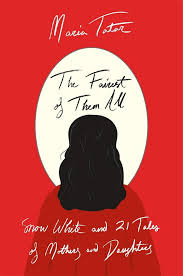Lucy Lethbridge at Literary Review:
 In its different versions, the tale has several recurring elements, though not all of them are present in every case. The chief one is the jealousy that rages in a beautiful mother (or stepmother, or mother-in-law) for her even more beautiful daughter. Then there is the mirror (or sometimes the sun or the moon and, in one version, a trout in a deep well) that reflects back to the mother the truth about her own beauty being surpassed. Someone is sent to kill the girl in the forest, sometimes a huntsman but occasionally an old woman or a witch; beguiled by the child’s beauty, they set her free, returning to the mother with a bloodstained shirt or an animal’s entrails. Lost in the forest, the child often comes upon a house in which to shelter. It might be lived in by untidy dwarfs (this gave Disney an opportunity to make Snow White into a perfect 1930s housewife), but often its inhabitants are immaculately tidy dwarfs (as in the Grimms’ version), and occasionally they are gangs of robbers or even brothers who look upon Snow White as a sister to be protected. Sometimes there are seven of them in the house, sometimes twelve.
In its different versions, the tale has several recurring elements, though not all of them are present in every case. The chief one is the jealousy that rages in a beautiful mother (or stepmother, or mother-in-law) for her even more beautiful daughter. Then there is the mirror (or sometimes the sun or the moon and, in one version, a trout in a deep well) that reflects back to the mother the truth about her own beauty being surpassed. Someone is sent to kill the girl in the forest, sometimes a huntsman but occasionally an old woman or a witch; beguiled by the child’s beauty, they set her free, returning to the mother with a bloodstained shirt or an animal’s entrails. Lost in the forest, the child often comes upon a house in which to shelter. It might be lived in by untidy dwarfs (this gave Disney an opportunity to make Snow White into a perfect 1930s housewife), but often its inhabitants are immaculately tidy dwarfs (as in the Grimms’ version), and occasionally they are gangs of robbers or even brothers who look upon Snow White as a sister to be protected. Sometimes there are seven of them in the house, sometimes twelve.
more here.
